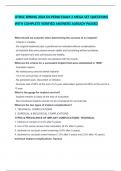Exam (elaborations)
UTHSC SPRING 2024 D3 PERIO EXAM 2 MEGA SET QUESTIONS WITH COMPLETE VERIFIED ANSWERS ALREADY PASSED
- Course
- Institution
UTHSC SPRING 2024 D3 PERIO EXAM 2 MEGA SET QUESTIONS WITH COMPLETE VERIFIED ANSWERS ALREADY PASSED What should we consider when determining the success of an implant? . Criteria is variable . the original treatment plan is performed as intended without complications . all implants that were...
[Show more]



